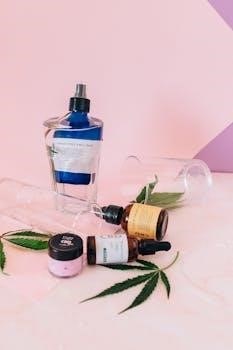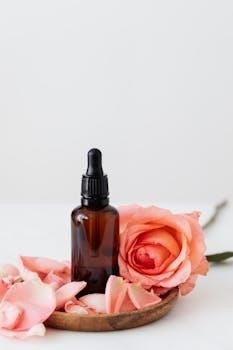Essential oils offer a natural approach to well-being․ Discover a world of aromatic extracts, each possessing unique properties․ Explore their diverse applications for physical and emotional health․ Unlock the potential of these botanical treasures․
What are Essential Oils?
Essential oils are concentrated, aromatic extracts derived from plants․ These oils capture the plant’s essence, including its scent and therapeutic properties․ They are typically extracted through distillation or cold pressing․ Each oil boasts a unique chemical composition, influencing its aroma and effects․
These natural compounds have been used for centuries in various cultures for medicinal and cosmetic purposes․ They are highly potent and should be used with care․ Understanding their properties and proper application is crucial for safe and effective use․
Essential oils are not the same as fragrance oils, which are synthetically produced․ True essential oils are pure and unadulterated, retaining the plant’s natural benefits․ Their versatility allows for use in aromatherapy, topical application, and even internal consumption (under professional guidance)․ From promoting relaxation to boosting energy, essential oils offer a holistic approach to wellness, making them a valuable addition to a natural lifestyle․ Exploring a list of essential oils and their uses in PDF format can provide a comprehensive guide for beginners and experienced users alike․

Common Essential Oils and Their Uses
Discover popular essential oils and their diverse applications․ From lavender’s calming effects to peppermint’s invigorating properties, explore how these oils can enhance your well-being․ Learn their specific uses and benefits․
Lavender Oil⁚ Benefits and Applications
Lavender oil, renowned for its soothing aroma, offers a multitude of benefits․ Its calming properties make it ideal for promoting relaxation and reducing stress․ Diffuse lavender oil to create a serene atmosphere, aiding sleep and easing anxiety․
Topical application of diluted lavender oil can soothe minor skin irritations, burns, and insect bites․ Its anti-inflammatory properties contribute to skin healing․ Lavender oil is also used in aromatherapy to alleviate headaches and muscle tension․
Furthermore, lavender oil is incorporated into various beauty products, such as lotions and shampoos, for its fragrance and skin-enhancing qualities․ Its versatility makes it a staple in natural remedies․ Whether diffused, applied topically, or added to personal care items, lavender oil provides a holistic approach to wellness․ Embrace the therapeutic power of lavender for a balanced mind and body․
Tea Tree Oil⁚ Uses for Skin and Health
Tea Tree Oil, derived from the Australian Melaleuca alternifolia tree, is celebrated for its potent antiseptic and anti-inflammatory properties․ It is a popular remedy for various skin conditions, including acne, fungal infections, and minor wounds․
Its antimicrobial action helps combat bacteria and fungi, making it effective in treating athlete’s foot and nail infections․ Diluted tea tree oil can be applied to acne-prone skin to reduce inflammation and prevent breakouts․ It also soothes insect bites and skin irritations․
Beyond skincare, tea tree oil may support oral health by fighting bacteria in the mouth․ It is often included in natural mouthwashes․ Furthermore, its immune-boosting properties make it a valuable addition to aromatherapy blends for respiratory support․ Embrace the versatile benefits of tea tree oil for a healthier you, but always dilute it properly before use․
Peppermint Oil⁚ Uses for Energy and Digestion
Peppermint oil, extracted from the Mentha piperita plant, is renowned for its invigorating scent and therapeutic properties․ It is widely used to boost energy levels and enhance mental alertness․ Inhaling peppermint oil can improve focus and concentration, making it a valuable aid for studying or working․
Moreover, peppermint oil is highly effective in supporting digestive health․ It can alleviate symptoms of indigestion, bloating, and gas․ Its antispasmodic properties help relax the muscles in the gastrointestinal tract, easing discomfort․ A diluted peppermint oil massage on the abdomen can promote healthy digestion․
Additionally, peppermint oil can relieve headaches and muscle pain․ Its cooling sensation provides a soothing effect․ Whether you seek an energy boost, digestive support, or pain relief, peppermint oil offers a refreshing and natural solution, but remember to dilute before topical application․

Safety Considerations and Guidelines
Prioritize safety when using essential oils․ Proper dilution is crucial to avoid skin irritation․ Be mindful of potential allergies and sensitivities․ Consult experts for guidance, especially during pregnancy․
Dilution Ratios and Application Methods
Understanding dilution ratios is paramount for safe essential oil use․ Concentrated oils can cause irritation if applied undiluted․ Always use a carrier oil like jojoba, almond, or coconut oil․ A general guideline is a 1-3% dilution for adults․ For children and the elderly, a 0․5-1% dilution is recommended․
Application methods vary depending on the desired effect․ Topical application involves applying diluted oil to the skin, often for localized relief․ Aromatherapy uses diffusers to disperse the scent into the air, promoting relaxation or focus․ Inhalation can be done directly from the bottle or by adding a few drops to a bowl of hot water․
Bath soaks are another popular method, but be sure to emulsify the oil with a carrier before adding it to the water․ Compresses, both warm and cold, can be used for targeted treatment․ Always perform a patch test before applying any new essential oil to a large area of skin․ Start with a low dilution and gradually increase as needed, paying close attention to your body’s response․
Oils to Avoid During Pregnancy and Breastfeeding
Pregnancy and breastfeeding necessitate extra caution when using essential oils․ Certain oils can pose risks to both mother and child․ Avoid oils with strong hormone-like effects, as they may interfere with pregnancy․ Common oils to avoid include clary sage, which can stimulate contractions․
Also, steer clear of pennyroyal, associated with potential toxicity․ Wintergreen, containing methyl salicylate, should be avoided due to its blood-thinning properties․ During breastfeeding, be cautious with peppermint, as it may reduce milk supply in some women․ Other oils to use with caution or avoid include anise, basil, camphor, hyssop, jasmine, juniper berry, marjoram, myrrh, rosemary, sage, and thyme․
Always consult with a qualified aromatherapist or healthcare professional before using any essential oils during pregnancy or breastfeeding․ Individual reactions can vary, so it’s crucial to prioritize safety․ Opt for milder, pregnancy-safe oils like chamomile, lavender (in moderation), and frankincense under expert guidance․

Essential Oil Blending and Aromatherapy
Explore the art of aromatherapy, where essential oils combine․ Create synergistic blends to enhance well-being and address specific needs․ Discover the power of scent for holistic healing and balance․
Creating Custom Blends for Specific Needs
Crafting bespoke essential oil blends allows for targeted support․ Consider the desired outcome, such as relaxation, focus, or invigoration․ Research the properties of individual oils to identify synergistic combinations․ Understand the concept of top, middle, and base notes to create balanced aromas․ A top note provides the initial impression, a middle note forms the body, and a base note offers longevity․
Experiment with different ratios to achieve the perfect scent profile and therapeutic effect․ Start with a small batch and test the blend before widespread use․ Dilution is crucial, especially for topical applications․ Use carrier oils like jojoba, almond, or grapeseed oil to ensure safety and enhance absorption․
Consider the individual’s preferences and sensitivities when creating a custom blend․ Keep detailed records of your formulations to replicate successful combinations․ With careful planning and experimentation, you can create personalized aromatherapy experiences tailored to specific needs․

Resources⁚ Printable Essential Oil Charts and Guides
Accessing reliable information is key to safe and effective essential oil use․ Printable charts and guides offer convenient references for various applications․ These resources often include oil profiles, blending suggestions, and safety precautions․ Look for charts that specify botanical names, extraction methods, and country of origin․
Essential oil use charts can categorize oils by therapeutic benefits, such as aiding sleep, boosting immunity, or relieving pain․ Some guides highlight oils safe for children and those to avoid during pregnancy․ Downloadable PDFs provide easy access to this information, whether at home or on the go․
Consider charts that detail dilution ratios for different application methods, from aromatherapy to topical use․ Remember to consult multiple sources and prioritize reputable information from certified aromatherapists or healthcare professionals․ These printable resources serve as valuable tools for both beginners and experienced essential oil enthusiasts․